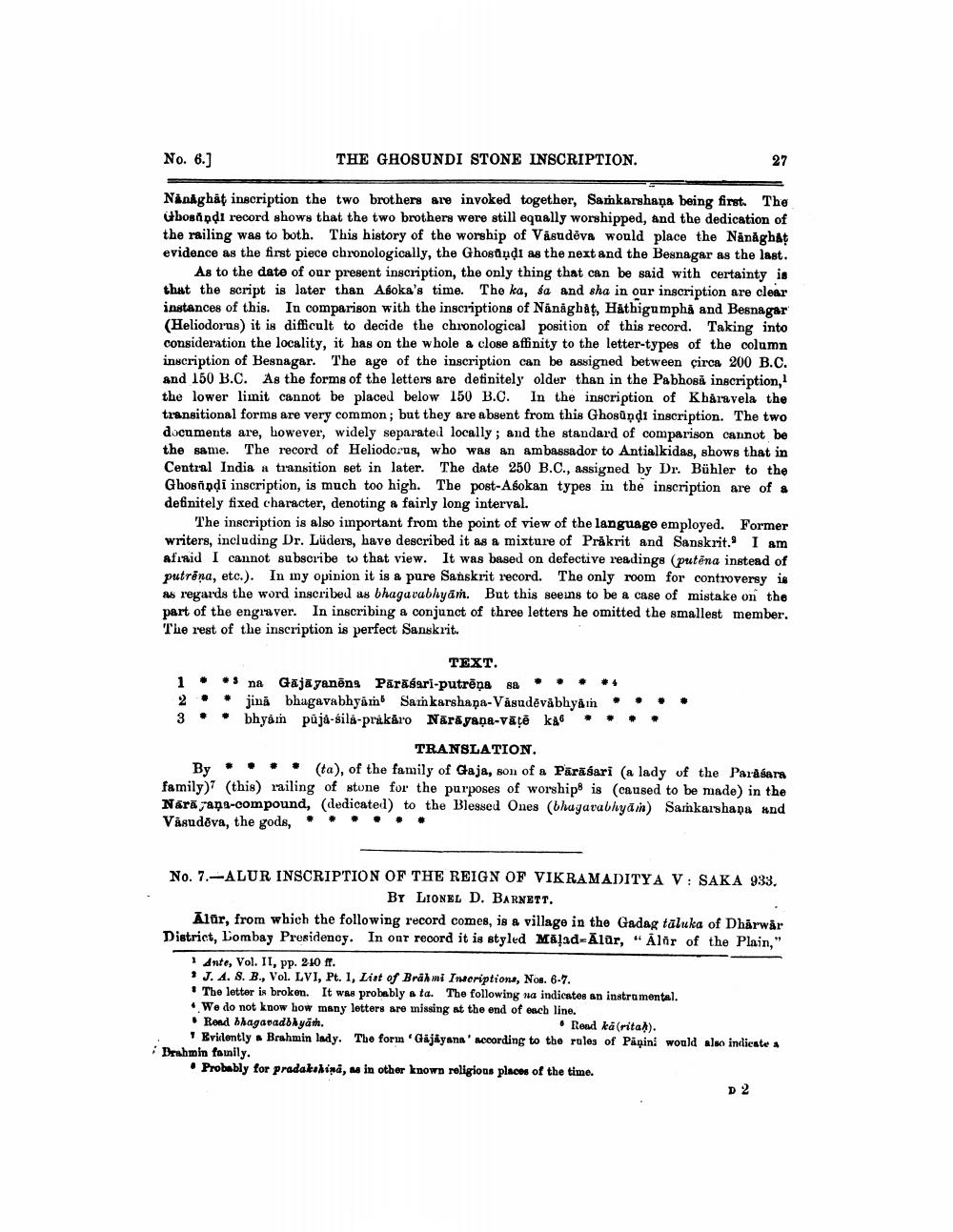________________
No. 6.]
THE GHOSUNDI STONE INSCRIPTION.
Nånághát inscription the two brothers are invoked together, Samkarshaņa being first. The Gbosandi record shows that the two brothers were still equally worshipped, and the dedication of the railing was to both. This history of the worship of Vasudeva would place the Nånåghat evidence as the first piece chronologically, the Ghostudi as the next and the Besnagar as the last.
As to the date of our present inscription, the only thing that can be said with certainty is that the script is later than Agoka's time. The ka, sa and sha in our inscription are clear instances of this. In comparison with the inscriptions of Nánåghat, Häthigumphi and Besnagar (Heliodorus) it is difficult to decide the chronological position of this record. Taking into consideration the locality, it has on the whole a close affinity to the letter-types of the column inscription of Besnagar. The age of the inscription can be assigned between circa 200 B.C. and 150 B.C. As the forms of the letters are detinitely older than in the Pabhoså inscription, the lower limnit cannot be placed below 150 B.C. In the inscription of Khåravela the transitional forms are very common; but they are absent from this Ghosundi inscription. The two documents are, however, widely separated locally; and the standard of comparison cannot be the same. The record of Heliodorus, who was an ambassador to Antialkidas, shows that in Central India a transition set in later. The date 250 B.C., assigned by Dr. Bühler to the Ghosn di inscription, is much too high. The post-Asokan types in the inscription are of a definitely fixed character, denoting a fairly long interval.
The inscription is also important from the point of view of the language employed. Former writers, including Dr. Lüders, have described it as a mixture of Prakrit and Sanskrit. I am afraid I cannot subscribe to that view. It was based on defective readings (putēna instead of putrēna, etc.). In my opinion it is a pure Sanskrit record. The only room for controversy is 26 regards the word inscribed as bhagavabhyāṁ. But this seeins to be a case of mistake on the part of the engraver. In inscribing a conjunct of three letters he omitted the smallest member. The rest of the inscription is perfect Sanskrit.
TEXT. 1. • na Gāja yanëns Paragari-putrēna sa • • • • 2 • . jiná bhagavabhyam Samkarshaņa-Vasudevabhydın ..bhyam puja-sila-pråkāro Nārāyaṇa-vātē kao
TRANSLATION By .. .. (ta), of the family of Gaja, son of a Paraíari (a lady of the Parabara family) (this) railing of stone for the purposes of worship is caused to be made) in the Nára jana-compound, (dedicated) to the Blessed Ones (bhugavabhya in) Sarkarshapa und Väsudova, the gods,
No. 7-ALUR INSCRIPTION OF THE REIGN OF VIKRAMADITYA V: SAKA 933.
BY LIONEL D. BARNETT. Alfir, from which the following record comes, is a village in the Gadag tāluka of Dharwår District, Lombay Prosidency. In ont record it is styled Majad-Alor, "Alor of the Plain,"
Ante, Vol. II, pp. 210 ff. + J. A. S. B., Vol. LVI, Pt. 1, Lint of Brahmi Imeriptions, Nos. 6-7. • The letter is broken. It was probably a ta. The following na indicates an instrumental • We do not know how many letters are missing at the end of each line. . Rond bhagavadbhyat.
Read ka(rital). 1 Brillently Brahmin lady. The forun Gajāyana' sccording to the rules of Panini would also indicate a Brahmin family.
• Probably for pradakshina, w in other known religious places of the time.




